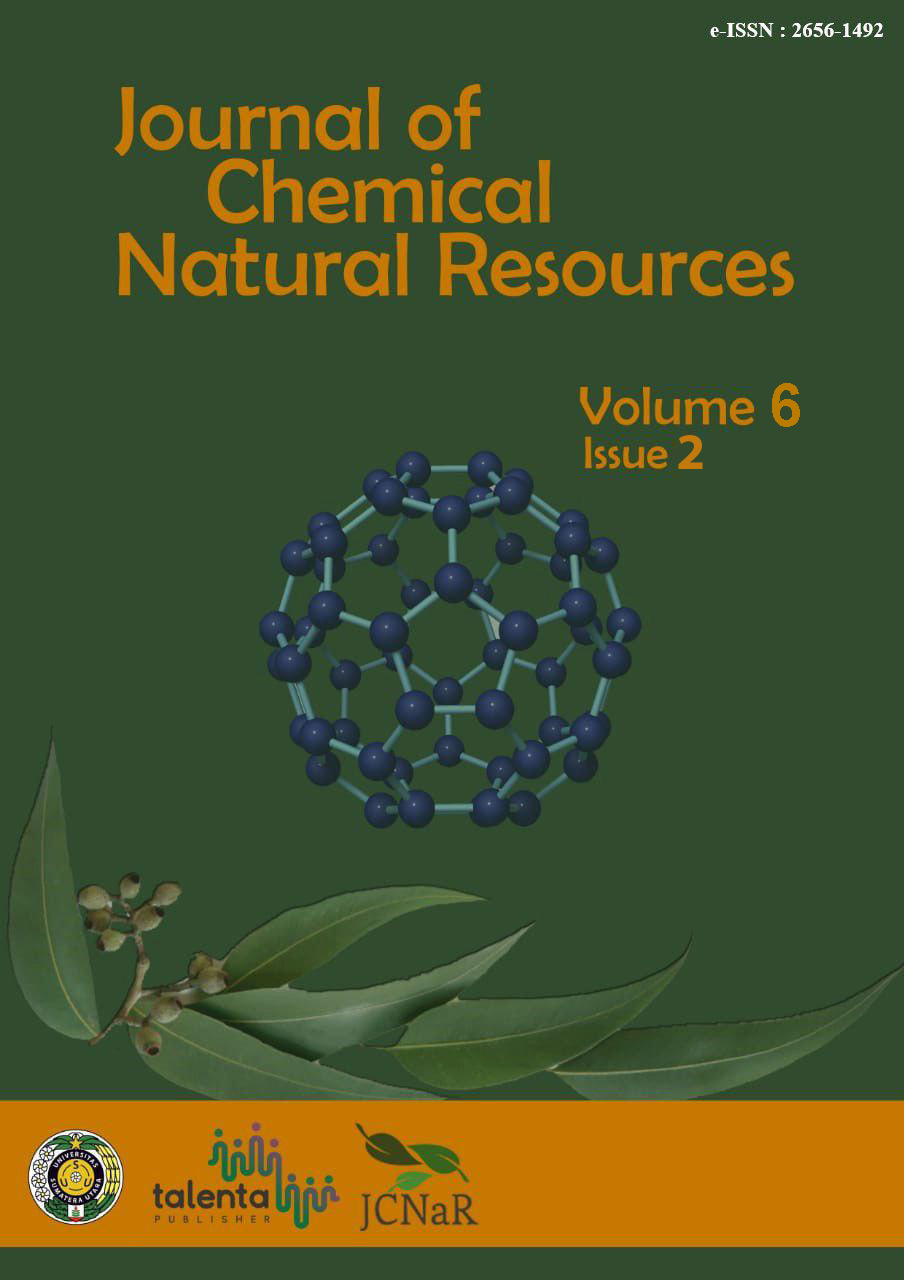Isolation and Identification of Flavonoid Compounds from Mangrove Leaves Burus (Bruguiera cylindrica (L.) Blume)
DOI:
https://doi.org/10.32734/jcnar.v6i2.18147Keywords:
Daun Mangrove, Flavonoid, Flavonol, Isolation, SpectrocopyAbstract
Flavonoid compounds have been successfully isolated from the Mangrove leave burus (Bruguiera cylindrica (L.) Blume) through a series of extraction processes. The maceration procedure, which involved soaking the material to be extracted in methanol solvent to allow the desired chemicals to dissolve gradually, was used for the first extraction. Following the addition of ethyl acetate, the extract was concentrated once more. This ethyl acetate extract is subsequently dissolved in methanol and partitioned with n-hexane. The obtained methanol layer was evaporated until dry, then analyzed using thin layer chromatography (TLC), with silica gel as the stationary phase and chloroform as the mobile phase. The composition of the chloroform:methanol eluent used varied (90:10, 80:20, and 70:30 v/v), and the pure amorphous solid compound with an orange-yellow color was successfully obtained using a 70:30 v/v eluent, weighing 16.3 mg and having an Rf value of 0.73. Compound identification was carried out using UV-Visible, FT-IR, and ¹H-NMR. Spectroscopic data indicate that the extracted compound belongs to the flavonol group.
Downloads
References
Indriaty, Djufri, B. Ginting, and K. Hasballah, “Phytochemical screening, phenolic and flavonoid content, and antioxidant activity of Rhizophoraceae methanol extract from Langsa, Aceh, Indonesia,†Biodiversitas, vol. 24, no. 5, pp. 2865–2876, 2023, doi: 10.13057/biodiv/d240541.
H. Hasnat et al., “A treasure house of prospective pharmacological potentials,†Heliyon, vol. 10, no. 6, p. e27533, 2024, doi: 10.1016/j.heliyon.2024.e27533.
V. Lobo, A. Patil, A. Phatak, and N. Chandra, “Free radicals, antioxidants and functional foods: Impact on human health,†Pharmacogn. Rev., vol. 4, no. 8, pp. 118–126, 2010, doi: 10.4103/0973-7847.70902.
W. Sun and M. H. Shahrajabian, “Potencial terapêutico de compostos fenólicos em plantas medicinais – produtos naturais de saúde para a saúde humana.,†Molecules, vol. 28, no. 4, p. 1845, 2023.
C. Kusmana, “Mangrove plant utilization by local coastal community in Indonesia,†IOP Conf. Ser. Earth Environ. Sci., vol. 196, no. 1, 2018, doi: 10.1088/1755-1315/196/1/012028.
Andianto, I. Wahyudi, R. K. Sari, G. Pari, and Y. H. Prayogo, “Phytochemical Profile of Rhizophora apiculata, Bruguiera gymnorhiza, and Bruguiera cylindrica for Wood Identification,†J. Sylva Lestari, vol. 12, no. 2, pp. 435–444, 2024, doi: 0.23960/jsl.v12i2.884.
J. Xuan et al., “Antimicrobial peptides for combating drug-resistant bacterial infections,†Drug Resist. Updat., vol. 68, no. March, p. 100954, 2023, doi: 10.1016/j.drup.2023.100954.
S. Egra et al., “Potential of prospective medicinal plants of Rhizophoraceae from North Kalimantan, Indonesia,†Biodiversitas, vol. 24, no. 3, pp. 1346–1355, 2023, doi: 10.13057/biodiv/d240303.
M. Krishnamoorthy, J. M. Sasikumar, R. Shamna, C. Pandiarajan, P. Sofia, and B. Nagarajan, “Antioxidant activities of bark extract from mangroves, Bruguiera cylindrica (L.) Blume and Ceriops decandra Perr,†Indian J. Pharmacol., vol. 43, no. 5, pp. 557–562, 2011, doi: 10.4103/0253-7613.84972.

Downloads
Published
Issue
Section
License
Copyright (c) 2024 Journal of Chemical Natural Resources

This work is licensed under a Creative Commons Attribution-ShareAlike 4.0 International License.














